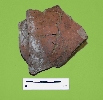Olomouc
A number of findings identified as imports from the Roman period come from the territory of Olomouc. The most interesting are findings of coins; however, the predominant majority of them are impossible to be found today. Archaeological researches conducted in the past fifty years by the Homeland Museum in Olomouc and National Heritage Institute Olomouc have only found some isolated findings from the Roman period in younger cultural layers. The findings of coins have been made near the St Wenceslas Cathedral, Lower and Blažejské Square, from Žižka Barracks, the earthen embankment of the demolished baroque fortification or from the former town brick kiln in the New Street.
St. Wenceslas
 A terra sigillata fraction has been found near the St. Wenceslas in the younger cultural layer from the 10th – 11th century. The orange-red colour fraction has a relief decoration in a leaf shape, parts of the body as griffin (right) and rear part as a boar (left). The shard comes from a bowl made somewhere around the today's town of Rheinzabern by workshops of master Regin II (app. end of the 2nd century – 1st half of the 3rd century).
A terra sigillata fraction has been found near the St. Wenceslas in the younger cultural layer from the 10th – 11th century. The orange-red colour fraction has a relief decoration in a leaf shape, parts of the body as griffin (right) and rear part as a boar (left). The shard comes from a bowl made somewhere around the today's town of Rheinzabern by workshops of master Regin II (app. end of the 2nd century – 1st half of the 3rd century).
Bricks and tiles
 During an archaeological research in the Theresian Armoury and under the stairs of the Church of our Lady of the Snow, National Heritage Institute Olomouc workers have found fractions of bricks and roof tiles in layers from the 10th – 11th century. These bricks and tiles are considered to be related to religious buildings of the early Middle Ages. The material is assumed to come from a Roman building from the Olomouc region not identified so far.
During an archaeological research in the Theresian Armoury and under the stairs of the Church of our Lady of the Snow, National Heritage Institute Olomouc workers have found fractions of bricks and roof tiles in layers from the 10th – 11th century. These bricks and tiles are considered to be related to religious buildings of the early Middle Ages. The material is assumed to come from a Roman building from the Olomouc region not identified so far.
Buckle
 In 1938, a unique finding of a bronze discoid perforated swastika-shaped buckle was published. The buckle was deemed to be found in the Slavonín cadastre by the Morava river. This type of buckle dates back to the second half of the 2nd century to the early 3rd century. The location of the buckle is not known. It is an example of buckles popular with legionnaires in Pannonia...(Peškař 1972, 44)
In 1938, a unique finding of a bronze discoid perforated swastika-shaped buckle was published. The buckle was deemed to be found in the Slavonín cadastre by the Morava river. This type of buckle dates back to the second half of the 2nd century to the early 3rd century. The location of the buckle is not known. It is an example of buckles popular with legionnaires in Pannonia...(Peškař 1972, 44)
Findings of coins
- St. Wenceslas – Galliena bronze coin (253-260) – Vienna coin cabinet (Dopita1986, 15)
- Žižka Barracks – great bronze of Gordian Pius (238-244) found in 1943 when gardening (Dopita 1986, 14)
- unknown locations – coins of Lucius Aelius, (136-138), Marciano (217-218), Dioclecianus (284-305), Iovius (363-364), … 4 more pieces found in 1788, owned by Dobrovský, Dopita 1986, 13, 14, 15
- Lower Square – in 1864 professor Jeitteles Antoninián found Gallienus (253-268), Dopita 1986, 15, Bláha 1986, 323
- Olomouc – New Street – 20 pcs of Claudius II Gothica to Valense (268-378) excavated before 1946




